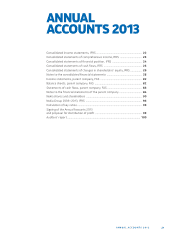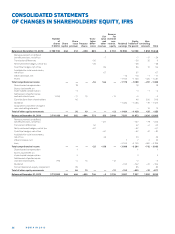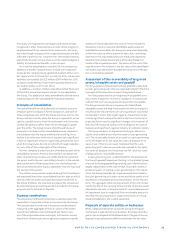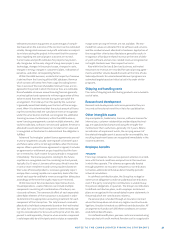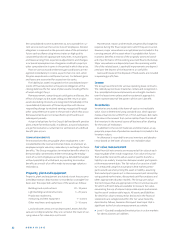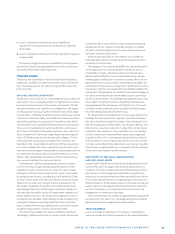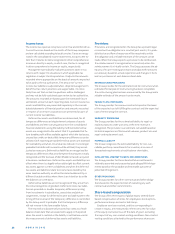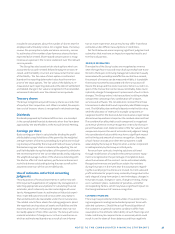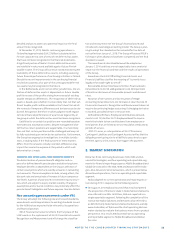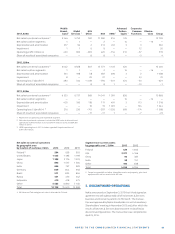Nokia 2013 Annual Report Download - page 33
Download and view the complete annual report
Please find page 33 of the 2013 Nokia annual report below. You can navigate through the pages in the report by either clicking on the pages listed below, or by using the keyword search tool below to find specific information within the annual report.31
NOTES TO THE CONSOLIDATED FINANCIAL STATEMENTS
telecommunications equipment on a percentage of comple-
tion basis when the outcome of the contract can be estimated
reliably. Recognized revenues and profi t estimates are subject
to revisions during the project in the event that the assump-
tions regarding the overall project outcome are revised.
Current sales and profi t estimates for projects may materi-
ally change due to the early stage of a long-term project, new
technology, changes in the project scope, changes in costs,
changes in timing, changes in customers’ plans, realization of
penalties, and other corresponding factors.
Within the HERE business, a substantial majority of revenue
is derived from the licensing of the HERE database. Revenue
which consists of license fees from usage (including license
fees in excess of the nonrefundable minimum fees), are rec-
ognized in the period in which the license fees are estimable.
Nonrefundable minimum annual licensing fees are generally
received upfront and represent a minimum guarantee of fees
to be received from the licensee during the period of the
arrangement. The total up-front fee paid by the customer
is generally amortized ratably over the term of the arrange-
ment. When it is determined that the actual amount of licens-
ing fees earned exceeds the cumulative revenue recognized
under the amortization method, we recognize the additional
licensing revenue. Furthermore, within the HERE business,
some licensing arrangements contain multiple elements, that
could include data, software, services and updates. Revenue is
allocated to each element based on its relative fair value and
is recognized as the element is delivered and the obligation is
fulfi lled.
Advanced Technologies’ patent license agreements are mul-
ti-year arrangements usually covering both a licensee’s past
and future sales until a certain agreed date, when the license
expires. When a patent license agreement is signed, it includes
an agreement or settlement on past royalties that the licen-
sor is entitled to. Such income for past periods is recognized
immediately. The license payments relating to the future
royalties are recognized over the remaining contract period,
typically to years. Licensees often pay a fi xed license fee
in one or more installments and running royalties based on
their sales of licensed products. Licensees generally report
and pay their running royalties on a quarterly basis after the
end of each quarter and Nokia revenue recognition takes place
accordingly at the time the royalty reports are received.
Within Devices & Services business reported as discon-
tinued operations, a sale of devices can include multiple
components consisting of a combination of hardware, ser-
vices and software. The commercial eff ect of each separately
identifi able element of the transaction is evaluated in order
to determine the appropriate accounting treatment for each
component of the transaction. The total amount received is
allocated to individual components based on their estimated
fair value. Fair value of each component is determined by tak-
ing into consideration factors such as the price when the com-
ponent is sold separately, the price when a similar component
is sold separately by a third party and cost plus a reasonable
margin when pricing references are not available. The esti-
mated fair values are allocated fi rst to software and services,
and the residual amount allocated to hardware. Application of
the recognition criteria described above generally results in
recognition of hardware related revenue at the time of deliv-
ery with software and services related revenue recognized on
a straight-line basis over their respective terms.
Also within the Devices & Services business, estimated
reductions to revenue are recorded for special pricing agree-
ments and other volume based discounts at the time of sale.
Sales adjustments for volume based discount programs are
estimated largely based on historical activity under similar
programs.
Shipping and handling costs
The costs of shipping and distributing products are included in
cost of sales.
Research and development
Research and development costs are expensed as they are
incurred as they do not meet the criteria for capitalization.
Other intangible assets
Acquired patents, trademarks, licenses, software licenses for
internal use, customer relationships and developed technol-
ogy are capitalized and amortized using the straight-line
method over their useful lives, generally to years. Where
an indication of impairment exists, the carrying amount of
the related intangible asset is assessed for recoverability. Any
resulting impairment losses are recognized immediately in the
income statement.
Employee benefi ts
PENSIONS
The Group companies have various pension schemes in accord-
ance with the local conditions and practices in the countries
in which they operate. The schemes are generally funded
through payments to insurance companies or contributions
to trustee-administered funds as determined by periodic
actuarial calculations.
In a defi ned contribution plan, the Group has no legal or
constructive obligation to make any additional contributions
even if the party receiving the contributions is unable to pay
the pension obligations in question. The Group’s contributions
to defi ned contribution plans, multi-employer and insured
plans are recognized in the consolidated income statements in
the period which the contributions relate to.
If a pension plan is funded through an insurance contract
where the Group does not retain any legal or constructive ob-
ligations, the plan is treated as a defi ned contribution plan. All
arrangements that do not fulfi ll these conditions are consid-
ered defi ned benefi t plans.
For defi ned benefi t plans, pension costs are assessed using
the projected unit credit method: Pension cost is recognized in


